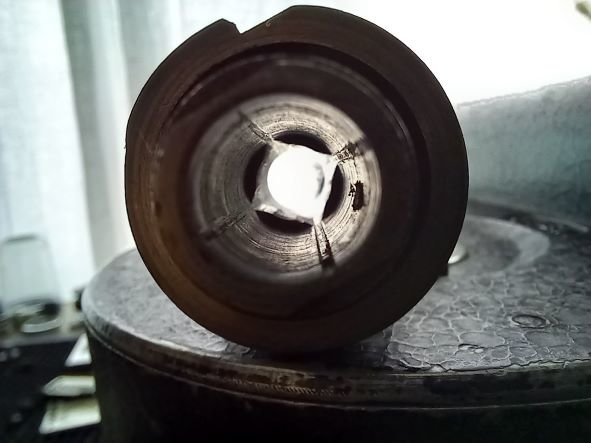-
Posts
2,587 -
Joined
-
Last visited
Everything posted by Simon Wyss
-
All the best, John! Yes, Wilhelm Conrad Röntgen (pronounced Röntgen) discovered the X-rays in 1895, so we could have transluced you with some overdose but positively. Reminds me of my natural adhesion L5-sacrum
-
Hi, Mohan Would you care to give a tiny bit of information about your experience with cameras or any other experience such as in the field of mechanics?
-
EKC should know. Eastman Kodak Company, Rochester NY
-
I ought to feel ashamed, you're right, David. We've lost our ground. The market is almost empty, void of value. No more black-and-white production. We drove the last negatives back to the producer last september. He himself run out of money. But worst: the archival world is not interested in any further development of the chemical film and mechanics. That has put me out of business. Half-finished apparatus, running projects, all wrapped up, one processing machine went into the shredder.
-
Please, don't say film when it is a video. I shouldn't have dropped in had you written 90mins one shot video. Forgive me everybody for I'm a chemical film man.
-
Cuckoo! Released in March 1958 Marcel Beaulieu's answer to the Paillard-Bolex H 16 Reflex and the Eumig C 16 (not a reflex camera) Is there anybody who owns one and would tell us his experience with the spring-drive chipper ? Kind regards
-

First time with 35...Mitchell NC vs Eyemo...
Simon Wyss replied to Kirk Anderson's topic in Mitchell
That's the Biograph camera of Lauste and Casler, 1895. It punches a neat perforation out of 35-mm. strips, has a suction pump that assures flatness in the aperture and is not very noisy. -

First time with 35...Mitchell NC vs Eyemo...
Simon Wyss replied to Kirk Anderson's topic in Mitchell
The Bell & Howell Eyemo was released in the spring of 1925. It is based on the 1923 Filmo which again goes back to a split film World War camera. -

Just got quoted to clean and lubricate my bolex OUCH
Simon Wyss replied to Dennis Goble's topic in Bolex
Ponder The EDIT function is not operative. -

Just got quoted to clean and lubricate my bolex OUCH
Simon Wyss replied to Dennis Goble's topic in Bolex
In my eyes a camera lubrication job should be rather cheap for a well-maintained camera needs lubrication more often than one thinks. A serious enterprise offers you a service standing order that includes winterizing, degreasing, oil and grease lube, the whole range. A Filmo is something different from a Bolex. While the Bell & Howell needs a few droplets of oil from the outside, the Paillard is made from much softer and more requiring materials. For instance, its governor has leather pads that rub on brass, they need a little oil. The axles are simple steel in plain bronze bearings, they must not run dry. And more Anyway, a trained mechanic opens, lubes and closes a Bolex within two hours (sans lenses). Pond yourself what you allow the man to charge. -
Black and white exclusively at one of three commercial swiss labs http://www.filmkunst.ch
-
Not so complicated, though. The difference from ISO 64 (Tungsten) to ISO 100 (undefined = Daylight) is 100 %. I put a third loss for the artificial light - daylight difference. So you can compare for instance f 5.6 to f 8 situations.
-
Like I said, you switch to and fro between exterior and interior shots which I don't seem to understand why. Perhaps it would have been rounder to have everything composed indoors. Don't take it personally, I'm giving my opinion, that's all. It is your movie and I like it still.
-
Films are only so and so long because there is a limit to how far one can stretch an idea. Most movies are too long and repetitive. Remember those wonderful days when the flicks came up and so many different little plots were brought to the screen, just like that? What a great movie: Explosion of a Motor Car by Cecil Hepworth, 1897! Run time one minute
-
I am liking it although it appears to me a little undecided with regard to int-ext.
-

school of hard knocks, or, just being a jerk?
Simon Wyss replied to Annie Wengenroth's topic in General Discussion
Let me support this. In my mother tongue: Der Mensch ist, was er isst. (Man is what he/she eats.) -

school of hard knocks, or, just being a jerk?
Simon Wyss replied to Annie Wengenroth's topic in General Discussion
Having worked with different labs I must say that this is nothing compared to what the gals had to take there but it is about twenty years ago. No, certainly the atmosphere must not become poisoned. To me as a rather blitzy guy those people were impressive who stayed calm all the time. In the end they delivered better work, far better than the angry or frantic or etchy or very funny ones. I believe it's got to do with home. -
Yes, you can. I once did such a job on commission. The client loaded 7302 into her camera, later we printed onto 7234. Besides the fog due to 7234's gray base we had a beautiful image. Furthermore, with Gigabitfilm such things are still easier to achieve today.
-
Let's say your can was only tape sealed. Then undoubtedly sea water would have penetrated into can and bag and would have left nothing more than some stained spots in the mud or perhaps a rusty something with no film. Even if the can was soldered watertight I'd doubt it would have withstood the attack by the sea water. As to the rest of your question: down there very little radiation, rather constant temperature, no gases to act on the film, nitrate almost certainly decomposed, acetate most likely in a useful condition, some fog. Developable in any case
-
You can't go totally wrong with the film since there is no 3⅔ holes perforation or so. Ah, yes, and the holes are evenly pitched all along the strip, believe it or not, at the accuracy of ¹/10,000 mm (fresh).
-

Breaking Down Large Rolls of Unexposed Film
Simon Wyss replied to Hal Smith's topic in Film Stocks & Processing
I'd rather say it's eating (from bulk). :) -
Prolsit, whether Lady or Gentleman, would you please be so kind to indicate your full name as is requested by this forum's rules. As to reversing -363: naturally you have less contrast. It's not a true reversal film but a rather thin layer especially designed for making sharp titles and the like.
-

Breaking Down Large Rolls of Unexposed Film
Simon Wyss replied to Hal Smith's topic in Film Stocks & Processing
We use footage counters in the darkroom to cut exact portions. The numbers within the counters themselves are painted with Rucolux, a so called safety lacquer. Before switching off the lights we flash them. -
I beg your pardon, but if one pushes the film will be overdeveloped, not overexposed. What a confusion here !


